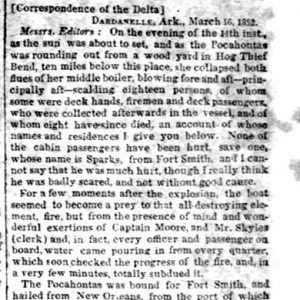calsfoundation@cals.org
Pocahontas [Steamboat]
The Pocahontas was a steamboat that ran between New Orleans, Louisiana, and cities along the Arkansas River. In 1852, the vessel suffered two fatal accidents, the second of which resulted in its destruction.
The Pocahontas was a 397-ton sidewheel paddleboat that was constructed in Cincinnati, Ohio, in 1849. By early 1852, the vessel was one of only three steamboats “running in the Arkansas river and New Orleans trade,” with Captain H. J. (or H. S.) Moore offering service to Little Rock (Pulaski County), Van Buren (Crawford County), Fort Smith (Sebastian County), and Fort Gibson, Indian Territory (present-day Oklahoma).
The Pocahontas’s first accident occurred on March 14, 1852, as the steamboat left the woodyard at Hog Thief Bend on the Arkansas River about ten miles below Dardanelle (Yell County). As the Pocahontas steamed up the Arkansas, both flues of its middle boiler collapsed, blowing scalding steam toward the vessel’s rear section and badly injuring eighteen people.
A correspondent to the Weekly Arkansas Gazette wrote that “it was a sad sight, and one which I have no anxiety to set my eyes on again. Soon after the collapse took place, the boat seemed for a moment to be inevitably doomed to the fire—but for the presence of mind and exertion of Capt. Moore and Mr. [John] Skyles, clerk, and, in fact of every officer and passenger on board, saved the boat; for at the command of the Captain, water came from every side, and soon subdued the flames.”
A total of eight of the scalding victims died that night or the next morning: three crew members and five people from the Barker and McDonald families from Indiana.
The Pocahontas was heading for New Orleans on April 16, 1852, and stopped at Napoleon (Desha County), where Captain Moore disembarked to journey to St. Louis, Missouri, leaving the steamboat under the command of John Skyles. The vessel was carrying 2,362 bales of cotton among other cargo, in addition to twelve passengers and forty-six crew members.
In an account published in the New Orleans Times-Picayune, H. L. Hedges, an officer on the Pocahontas, said that a passenger told him at about 10:00 p.m. that he smelled smoke. Hedges and another crew member went to the passenger deck to investigate but found nothing burning, though they did not go to the lower decks.
The steamboat was about thirty miles below Napoleon when an alarm of fire was raised from the lower deck at about 10:40 p.m. Flames that had started on the boiler deck burst from the front of the ship near the chimneys, and that part of the vessel was soon fully ablaze, trapping the captain and several crew members. The pilot attempted to run the Pocahontas ashore, but the tiller rope burned through, and the ship drifted downstream, slowly turning in the current. The men at the front of the ship leapt overboard, clinging to cotton bales, planks, and drifting logs.
The passengers and crew who were huddled at the back of the ship also had to jump overboard. Though crew members threw cotton bales overboard for them to cling to, an African American woman named Maria and her daughter Adelaide hesitated to leap into the water; by the time they did, the bales had floated away, and both drowned. In addition, former Arkansas County sheriff John L. Jones and a Little Rock woman and her three children drowned, and a cabin boy and two of the ship’s firemen were believed to have perished. The Arkansas Whig later reported that it had learned “upon good authority” that only nine people died in the disaster, so it is possible that one of the latter three survived.
“In fifteen minutes after the alarm was given, the entire cabin, forward of the wheels, was in flames,” Hedges reported. “In fifteen minutes more, the boat was burnt to the water’s edge. The wind was high and the boat burned with singular rapidity and fierceness.” The Pocahontas sank in twenty feet of water.
Some of the crew and passengers escaped the flames on the Pocahontas’s yawl, which dropped them off on Island 78 before venturing out to gather other people in the river who were clinging to cotton bales, driftwood, and other flotsam. All were lightly dressed and soaking wet on the cold night and huddled around a fire for three hours until the steamboats Saxon, Susquehanna, and Magnolia arrived and rescued them. Several passengers published cards in the Daily Picayune thanking the officers of the vessels for rescuing them and “for contributions of cash and clothing tendered us, we having lost everything by the conflagration.”
For additional information:
“Another Steamboat Explosion and Loss of Life.” Weekly Arkansas Gazette (published as Arkansas State Gazette and Democrat), March 19, 1852, p. 2.
“Arkansas River Packet, Pocahontas” [Advertisement]. Weekly Arkansas Gazette, February 27, 1852, p. 3.
“Burning of the Pocahontas—Loss of Life.” Times-Picayune, April 20, 1852, p. 2.
“A Card.” Daily Picayune, April 20, 1852, p. 1.
“A Demand for Steamboats.” Weekly Arkansas Gazette, March 26, 1852, p. 2.
“Explosion of the Pocahontas.” Weekly Arkansas Gazette (published as Arkansas State Gazette and Democrat), March 26, 1852, p. 2.
Lloyd, James T. Lloyd’s Steamboat Directory, and Disasters on Western Waters, Cincinnati: T. J. Lloyd & Co., 1856.
“The Pocahontas.” Arkansas Whig, May 6, 1852, p. 2.
“Steamboat Pocahontas Burnt! Thirteen Lives Lost—2500 bales of Cotton Destroyed!!!” Weekly Arkansas Gazette (published as Arkansas State Gazette and Democrat), April 23, 1852, p. 2.
Way, Frederick, Jr., comp. Way’s Packet Directory, Athens: University of Ohio Press, 1983.
Mark K. Christ
Central Arkansas Library System
 Louisiana Purchase through Early Statehood, 1803 through 1860
Louisiana Purchase through Early Statehood, 1803 through 1860 Transportation
Transportation Pocahontas Steamboat Article
Pocahontas Steamboat Article 



Comments
No comments on this entry yet.